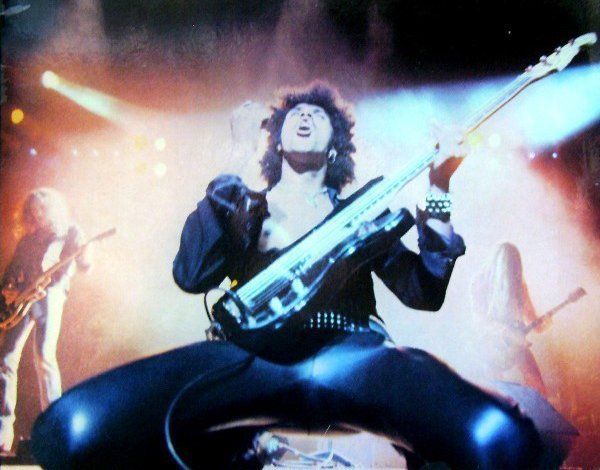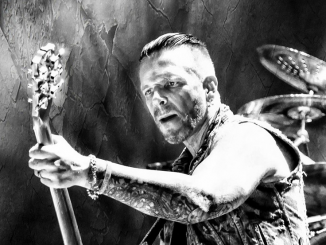
Deep Dive: Take a Deep Dive into some of XS Noize contributors’ favourite artists. We’ll guide you through back catalogues, side projects and career highlights so you can choose which music to put at the top of your listening list. Perfect for discovering your new favourite act, or finding out more when you’ve only just scratched the surface. Check out the latest Deep Dive: The Coyote Call – An Introduction to Phil Lynott
Phil Lynott’s contribution to music is immeasurable. Before his death, aged just 36, he was best known for fronting his band, Thin Lizzy. The rock band will always be remembered for its dual guitar attack, Brian Downey’s signature drumming shuffle and Lynott, font and centre, pounding the bass and singing about cowboys and vagabonds, Romeos and lonely girls.
Lynott’s imprint reaches much further than the classic rock they’re associated with though. With Thin Lizzy, he also covered folk, psychedelia, hard rock and metal, but as a solo artist he branched out into spoken word, synth-pop, reggae and R&B to show he was much more than the leather-clad frontman of a rock band. Lynott was a musical chameleon, aligning himself with the punk and new wave sounds which developed as the main challengers to rock in the early eighties.
This Deep Dive will take you through Phil Lynott’s musical output, from Thin Lizzy to his solo and side projects. For Thin Lizzy material, rather than go album by album, we’ll focus on the band’s historic Live and Dangerous album, voted best ever live album by more publications than we can shake a stick at. It’s just that good.
Are you out there?
Live and Dangerous was recorded over several dates during Thin Lizzy’s peak between 1976 and 1977 when they released three studio albums and completed several tours of the UK, Europe and America. While many live albums are the capture of a single gig or event, Live and Dangerous merges the best performances of Thin Lizzy over several nights. Producer Tony Visconti has suggested little of the album is actually live after a series of overdubs, but the band refutes this to varying degrees and nobody can really be sure how live Live and Dangerous is. Does it even matter?
The album features tracks which tick all the boxes of Lynott’s frequent styles of writing, he’s simultaneously the leader of a gang, a hopeless romantic and a fan of crime fiction as well as Irish history and mythology.
Lynott regularly sings about “Me and the boys”, or “the boys” and positions himself at the head of a crowd of hell-raisers. In Jailbreak, Cowboy Song and The Boys Are Back In Town Lynott evokes the bravado and machismo of a leader of men. He’s “Bustin’ out dead or alive”, or warning onlookers that “If the boys wanna fight you better let ‘em”. He’s the ultimate alpha, stalking the stage in his leather trousers, long legs and good looks demanding the attention of anyone in sight.
Later on Live and Dangerous the pack mentality is used more as a call to action than a narrative device. Are You Ready, Baby Drives Me Crazy, and the Downey drum solo powered Sha-La-La are included because they get the crowd involved, rather than the quality of the songs. Compared to the rest of Live and Dangerous, this trio is fairly weak but serves an important purpose in bridging the gap between band and fans.
The Rocker closes Live and Dangerous on a high. Taken from the Vagabonds of the Western World album, and possibly original guitarist Eric Bell’s best contribution to the band, it’s a stomping rock track made classic by Lynott’s turn of phrase. It’s one of the earliest examples in Thin Lizzy’s catalogue of the American influence on Lynott’s writing, as well as the beginning of Phil Lynott the rock star replacing the folk and beat poetry writing teenager.
Even Lynott can be beaten though and Fighting My Way Back on 1975 album Fighting, puts Lynott as the dethroned hero working his way back to the top, while Wild One from the same album is a semi-autobiographical plea to the rebel on the run. Southbound from Johnny The Fox and featured on Live and Dangerous, and Renegade, title tracks from the band’s 1981 album, betray the lonelier side of fronting the gang. The machismo mask slips and we see Lynott as a lone wolf, still resolute and determined but isolated. Earlier tracks during Thin Lizzy’s height portray Lynott as beaten but on the upswing. But, by 1979 on the Black Rose album, Lynott cuts a sorry figure in tracks like Got To Give It Up, as addiction and the break up of the band begin to wear on him, making the upswing seem like a distant possibility rather than an inevitability.
Lynott the romantic is probably the most frequent inspiration for Thin Lizzy songs. On Live and Dangerous alone, Lynott goes from the playful romantic of Dancing In The Moonlight, to the broken desperation of Still In Love With You, the estranged lover of Cowboy Song to the warning lothario of Don’t Believe A Word.
Like no other “rock star” Lynott could sing in Dancing In The Moonlight about “Chocolate stains on my pants” and defying his father’s wishes to make a date with a girl he “caught with a glance”. On Jailbreak’s Running Back Lynott admits that his lover could push him away as far as possible but he’d still return to her. Earlier, Look What The Wind Blew In on 1971 album Thin Lizzy features a play on words involving an ex-called Gail, while Dear Miss Lonely Hearts, opening track of his 1980 solo album Solo In Soho, records the exchange between two people and an agony aunt who mixes up their letters. Musically and lyrically the songs might sound tame in comparison to the bravado of Jailbreak or the hard rock chaos of Massacre but Lynott toes the line between pop and rock beautifully to illustrate the diversity of his writing.
Still In Love With You is Lynott’s masterpiece. For all the commercial success of other tracks, this is Lynott at his best. Recorded in a series of sessions with Gary Moore on guitar after Eric Bell had left the band, Still In Love With You has Lynott confused, desperate and finally accepting of the breakdown of a relationship. Released on 1973 album Nightlife, with Gary Moore’s solo included because new guitarist Brian Robertson admitted the original couldn’t be bettered, it’s an early example of just how good a writer Lynott was. Moving Thin Lizzy away from the Celtic folk of the Eric Bell era, Lynott’s phrasing became tighter, song construction more solid and more confident in the simplicity of the music. The song’s chorus might only be one line, but its delivery communicates more than any number of words could. On Live and Dangerous, Robertson and Gorham combine to finish the song with some of the best guitar solos you’ll hear.
Lynott’s passion for Ireland and history are prominent in Emerald, Warriors and Massacre. All taken from 1976’s Jailbreak album, they feature war, colonisation and destruction. The Celtic inspired Emerald tells of raiders “Come to claim the Emerald,” and could easily be taken as a prequel to Black Rose, released in 1979 on Gary Moore’s only full album with the band. Ireland had already inspired songs like Eire and Dublin on the 1971 Thin Lizzy album, while Old Town on Lynott’s debut album Solo In Soho (1980), is another ode to his home city.
Massacre is less specifically a reference to Ireland, but like Soldier of Fortune (Bad Reputation, 1977), Angel of Death (Renegade, 1981), The Holy War (Thunder and Lightning, 1983) and The Friendly Ranger At Clontarf Castle (Thin Lizzy, 1971) with its spoken-word intro, it provides insight into Lynott’s fascination with war and history. Throughout his career, Lynott showed he could draw from influences ranging from prehistoric to the twentieth century and even the futuristic Warriors, which featured on Live and Dangerous.
Lynott’s ability to weave fiction through his writing leaves some ambiguity about how personal some of his characters might be.
Suicide, from 1975 album Fighting has a film noir feel about it, with dark alleyways, a mysterious murder and a suspicious cop. It’s unlikely to be overly personal for Lynott but shows his fascination with the genre.
Elsewhere, Lynott puts himself into songs through the use of a variety of semi-fictional characters. Johnny The Fox Meets Jimmy The Weed and Johnny from 1976’s Johnny The Fox album, features a shady protagonist who may or may not be some extension of Lynott himself. Valentino features as a troubled gambler in Waiting For An Alibi (Black Rose, 1979), and Rocky (Johnny The Fox, 1976) is said to be about lead guitarist Brian Robertson, whose involvement in a bar fight ahead of a US tour was a big factor in his eventual exit from the band in 1978.
Some tracks which appear on later albums (Got To Give It Up, Bad Habits, Hollywood and Heart Attack) refer openly to vice and addictions and are more often in the first person. After his death in 1986, lyrics to songs like Heart Attack take on even more significance.
While Live And Dangerous was Thin Lizzy’s peak, things hadn’t been smooth during the years before the release of the double LP.
Three albums released by Decca records had been commercial failures, but that doesn’t mean they should be written off. With Eric Bell on guitar, they are almost unrecognisable from the band that would go on to create Live And Dangerous, there are glimpses of promise on all three records.
Thin Lizzy (1971) and Shades Of A Blue Orphanage (1972) were much more folk than rock. Based mostly around acoustic guitars, Bell’s virtuoso and freestyle playing and Lynott’s poetic lyrics, they wouldn’t have been out of place in the previous decade. Look What The Wind Blew In, Dublin, Eire are among the most interesting, while third album Vagabonds Of The Western World (1973) hardens to a bluesier tone with The Rocker and Gonna Creep Up On You.
Apparently, against the band’s wishes, Decca released Whiskey In The Jar as a single, and it became a hit in the UK and Ireland. Although the band’s first sign of success to that point, it brought about the end of Eric Bell’s involvement as he became disillusioned with touring and quit in the middle of a gig in his hometown of Belfast.
His dramatic exit encouraged Lynott to recruit two guitarists rather than one and Gorham and Robertson joined Lynott and Downey for the classic Thin Lizzy lineup. The folk-tinged trad of Whiskey In The Jar became more of a hindrance than a help as the band tried to reassert itself as a rock quartet. The Nightlife and Fighting albums enjoyed limited success and got the band onto support slots with Status Quo, Slade and Bachman Turner Overdrive, but it would be 1976 before Thin Lizzy would really begin to be well known globally with the release of Jailbreak.
From Moore to Snowy, to Sykes to solo
Just months after Live And Dangerous was released, Thin Lizzy’s classic lineup was finished as Brian Robertson left the band. He was replaced by Gary Moore, who for the first time joined the band as a permanent member. Having already contributed to Thin Lizzy’s success with tracks like Little Darling and Still In Love With You, he was a natural replacement with the added benefit of backing vocals. Black Rose, released in 1979, was the band’s hardest sounding album so far, and its reeling title track still frustrates ambitious guitarists the world over. Recorded near Paris’s red-light district, the sleazy surroundings come through on the record with tracks like Toughest Street In Town, S&M and Got To Give It Up, as Lynott moved away from the “Me and the boys” tone made famous by Live And Dangerous.
Outside of Thin Lizzy, Moore and Lynott also combined on the battle tale of Out In The Fields (1985) and the sublime Parisienne Walkways (1979), with Lynott contributing to Moore’s solo projects.
Gary Moore left soon after Black Rose’s release and was replaced by Midge Ure of Ultravox. Ure had been writing with Lynott between 1979 and 1980 and was drafted in to tour when Moore left, before switching to keyboards when Snowy White was recruited for the very hit and miss Renegade album in 1981.
The Ure/Lynott partnership was most successful with the track Yellow Pearl which was Top Of The Pops theme song from 1981-86. The synth-driven track illustrates perfectly Lynott’s desire to stay ahead of music trends. As rock became unfashionable in the eighties, Lynott formed bands with members of the Sex Pistols (The Greedy Bastards, producing a Christmas single in 1979), and wrote with Midge Ure and Mark Knopfler (Kings Call) to maintain his status in a rapidly changing music scene.
Lynott’s first solo album, Solo In Soho, was released in 1980, in between Thin Lizzy’s Black Rose and Renegade. It featured the cheesy pop-rock of Dear Miss Lonely Hearts, a tribute to Elvis in King’s Call, and the synth-pop of Yellow Pearl. The move towards solo releases though gave Lynott more scope to experiment, and this was taken further on his self-titled 1982 album with Fatalistic Attitude and Old Town worth a listen.
By 1983 Thin Lizzy were on to another new guitarist with John Sykes recruited from the Tygers of Pan Tang. Thunder and Lightning, released in 1983 was more New Wave Of British Heavy Metal than the classic rock of the seventies. (Spare a thought for Scott Gorham who found himself partnering an ever-changing variety of guitarists!)
The album is yet more evidence of Lynott’s adapting to suit the musical landscape as Thunder and Lightning, The Holy War and Baby Please Don’t Go tackle familiar themes of death, war and romance, but with a distinctly harder edge.
Thin Lizzy finally split in 1983, but Lynott fronted Grand Slam playing Thin Lizzy and solo material until 1985. His final single was Nineteen, released in December 1985 and written with Grand Slam guitarist Laurence Archer, keyboardist Mark Stanway and producer Paul Hardcastle. Hardcastle had had a hit with a single of the same name earlier that year, showing that to the end, Lynott was looking to develop his style and stay relevant, despite the demise of Thin Lizzy.
Is This The End?
Phil Lynott died on 4 January 1986, leaving behind a musical legacy that’s just as strong more than 30 years later.
It’s thought Lynott was devastated at being snubbed for Live Aid in 1985, organised by former Thin Lizzy member Midge Ure and Dubliner Bob Geldof, whose Boomtown Rats had been championed by Lynott. In Graham Thompson’s excellent biography, Midge Ure admits that Lynott wasn’t even considered for the gig, despite other dissolved bands like Status Quo reforming for it.
We can only imagine the what-ifs had Thin Lizzy reformed and belted out The Boys Are Back In Town at a packed-out Wembley.
Thin Lizzy has continued under various guises, with John Sykes fronting the band, then Ricky Warwick fronting with Downey and Gorham involved. Most recently Brian Downey’s Live And Dangerous have been on tour, while Gorham occasionally gigs as Thin Lizzy with Black Star Riders members completing the lineup.
Lynott’s music regularly reappears in pop culture, television adverts and more, and has been covered by acts as diverse as The Corrs, Sadé and The Smashing Pumpkins, showing just how wide-ranging his writing was.
Deep Dive – The Coyote Call – An Introduction to Phil Lynott
Essential: Jailbreak, Live And Dangerous
Deep Dive: Solo in Soho, Thin Lizzy
Reading: My Boy, Philomena Lynott. Cowboy Song, Graham Thompson.





Be the first to comment